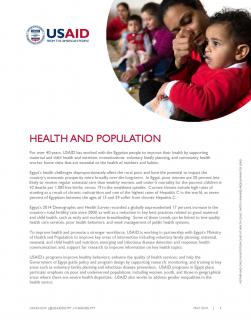For over 40 years, USAID has worked with the Egyptian people to improve their health by supporting maternal and child health and nutrition, immunizations, voluntary family planning, and community health worker home visits that are essential to the health of mothers and babies.
Egypt’s health challenges disproportionately affect the rural poor and have the potential to impact the country’s economic prosperity more broadly over the long-term. In Egypt, poor women are 20 percent less likely to receive regular antenatal care than wealthy women, and under-5 mortality for the poorest children is 42 deaths per 1,000 live births, versus 19 in the wealthiest quintile. Current threats include high rates of stunting as a result of chronic malnutrition and one of the highest rates of Hepatitis C in the world, as seven percent of Egyptians between the ages of 15 and 59 suffer from chronic Hepatitis C.
Egypt’s 2014 Demographic and Health Survey recorded a globally unprecedented 17 percent increase in the country’s total fertility rate since 2008, as well as a reduction in key best practices related to good maternal and child health, such as early and exclusive breastfeeding. Some of these trends can be linked to low-quality health care services, poor health behaviors, and weak management of public health systems.
To improve health and promote a stronger workforce, USAID is working in partnership with Egypt’s Ministry of Health and Population to improve key areas of intervention including voluntary family planning; maternal, neonatal, and child health and nutrition; emerging and infectious disease detection and response; health communication; and, support for research to improve information on key health topics.
USAID’s programs improve healthy behaviors; enhance the quality of health services; and help the Government of Egypt guide policy and program design by supporting research, monitoring, and training in key areas such as voluntary family planning and infectious disease prevention. USAID programs in Egypt place particular emphasis on poor and underserved populations, including women, youth, and those in geographical areas where there are severe health disparities. USAID also works to address gender inequalities in the health sector.

